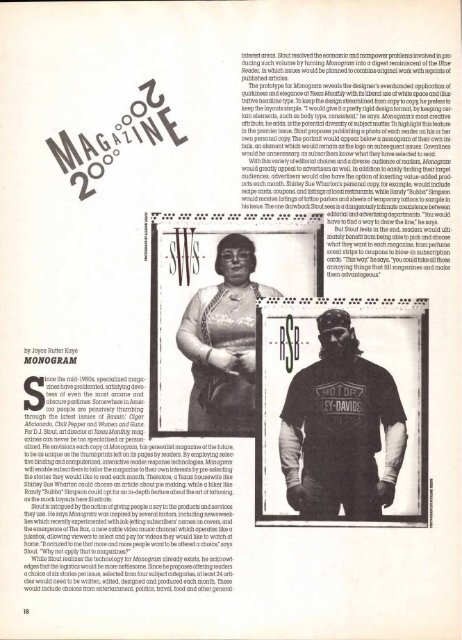Volume 19–4 (Low Res).pdf
Volume 19–4 (Low Res).pdf
Volume 19–4 (Low Res).pdf
You also want an ePaper? Increase the reach of your titles
YUMPU automatically turns print PDFs into web optimized ePapers that Google loves.
y Joyce Rutter Kaye<br />
MONOGRAM<br />
ince the mid-1980s, specialized maga-<br />
zines have proliferated, satisfying devo-<br />
tees of even the most arcane and<br />
obscure pastimes. Somewhere in Amer-<br />
ica people are pensively thumbing<br />
through the latest issues of Bassin: Cigar<br />
Aficionado, Chili Pepper and Women and Guns.<br />
For D.J. Stout, art director at Texas Monthly, magazines<br />
can never be too specialized or personalized.<br />
He envisions each copy of Monogram, his generalist magazine of the future,<br />
to be as unique as the thumbprints left on its pages by readers. By employing selective<br />
binding and computerized, interactive reader-response technologies, Monogram<br />
will enable subscribers to tailor the magazine to their own interests by pre-selecting<br />
the stories they would like to read each month. Therefore, a Texas housewife like<br />
Shirley Sue Wharton could choose an article about pie making, while a biker like<br />
Randy "Bubba" Simpson could opt for an in-depth feature about the art of tattooing,<br />
as the mock layouts here illustrate.<br />
Stout is intrigued by the notion of giving people a say in the products and services<br />
they use. He says Monogram was inspired by several factors, including newsweeklies<br />
which recently experimented with ink-jetting subscribers' names on covers, and<br />
the emergence of The Box, a new cable video music channel which operates like a<br />
jukebox, allowing viewers to select and pay for videos they would like to watch at<br />
home. "It occured to me that more and more people want to be offered a choice: says<br />
Stout. "Why not apply that to magazines?"<br />
While Stout realizes the technology for Monogram already exists, he acknowledges<br />
that the logistics would be more nettlesome. Since he proposes offering readers<br />
a choice of six stories per issue, selected from four subject categories, at least 24 articles<br />
would need to be written, edited, designed and produced each month. These<br />
would include choices from entertainment, politics, travel, food and other general-<br />
18<br />
interest areas. Stout resolved the economic and manpower problems involved in producing<br />
such volume by turning Monogram into a digest reminiscent of the Utne<br />
Reader, in which issues would be planned to combine original work with reprints of<br />
published articles.<br />
The prototype for Monogram reveals the designer's evenhanded application of<br />
quirkiness and elegance at Texas Monthlywith its liberal use of white space and illustrative<br />
headline type. To keep the design streamlined from copy to copy, he prefers to<br />
keep the layouts simple. "I would give it a pretty rigid design format, by keeping certain<br />
elements, such as body type, consistent;' he says. Monogram's most creative<br />
attribute, he adds, is the potential diversity of subject matter. To highlight this feature<br />
in the premier issue, Stout proposes publishing a photo of each reader on his or her<br />
own personal copy. The portrait would appear below a monogram of their own initials,<br />
an element which would remain as the logo on subsequent issues. Coverlines<br />
would be unnecessary, as subscribers know what they have selected to read.<br />
With this variety of editorial choices and a diverse audience of readers, Monogram<br />
would greatly appeal to advertisers as well. In addition to easily finding their target<br />
audiences, advertisers would also have the option of inserting value-added products<br />
each month. Shirley Sue Wharton's personal copy, for example, would include<br />
recipe cards, coupons, and listings of local restaurants, while Randy "Bubba" Simpson<br />
would receive listings of tattoo parlors and sheets of temporary tattoos to sample in<br />
his issue. The one drawback Stout sees is a dangerously intimate coexistence between<br />
*** *Ty editorial and advertising departments. "You would<br />
00, 400, have to find a way to draw the line: he says.<br />
But Stout feels in the end, readers would ultimately<br />
benefit from being able to pick and choose<br />
what they want in each magazine, from perfume<br />
scent strips to coupons to blow-in subscription<br />
cards, "This way" he says, "you could take all those<br />
annoying things that fill magazines and make<br />
them advantageous:<br />
odio oodo 000 se* too. 000 000 0oo *se<br />
S.. oleo 41041 555 froo *so woo roo oof
















